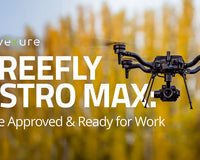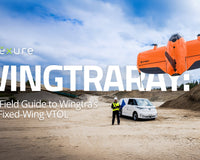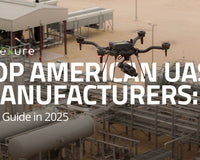The sun dips low over the horizon, casting long shadows across a sprawling pasture. Dust kicks up as you ride along the edge of the field, scanning your herd for signs of trouble. Somewhere beyond the nearest hill, a calf shows signs of illness. Catching it early could mean the difference between a quick recovery and a costly loss, but locating it among hundreds of cattle spread across miles is no easy task.
This is where drones step in. With a thermal-equipped drone, you could locate that calf within minutes, pinpointing it by body heat and confirming its condition—all without disturbing the herd. Unmanned aerial systems (UAS) or drones allow ranchers to respond faster, monitor health remotely, and manage their livestock more efficiently than ever before. Here’s how drones are transforming livestock management.
Health Monitoring Made Easy

For large herds, health issues often go unnoticed until they become serious. Spotting a sick animal early can prevent costly losses, but inspecting each animal manually is both time-consuming and physically demanding. This is where drones provide a big advantage.
Equipped with thermal cameras, drones allow ranchers to detect animals with elevated body temperatures—a common early sign of illness. By flying over the herd, a drone can quickly identify animals showing signs of fever or distress from above, all without disturbing the rest of the herd.
During calving season, drones become invaluable tools for monitoring cows and their calfs. From an aerial perspective, it’s easy to observe calving without causing stress to the animals, yet still stay close enough to catch any issues like prolonged labor, distress, or abandoned calves. With real-time data, ranchers can respond quickly to any emerging problems.
In practical terms, drones turn what could be hours of on-foot searching into just minutes of efficient monitoring.
Efficient Pasture and Water Management

Healthy pastures and accessible water are vital to livestock, but keeping them in top condition across vast areas presents a challenge. Overgrazed land can lead to soil erosion, weed overgrowth, and decreased pasture quality, all of which directly impact herd health and productivity. Likewise, ensuring water sources remain clean and accessible is essential, especially when herds are spread over large distances.
Drones equipped with high-resolution RGB and multispectral sensors make managing pastures and water sources more efficient. With a quick flight, drones can capture detailed images that reveal signs of overgrazing, soil erosion, or areas where weeds are beginning to take over. This insight helps ranchers identify sections of land that may need rest or rotation, preserving pasture health and extending grazing time.
Drones also allow ranchers to monitor water sources from above, quickly identifying issues such as leaks, contamination, or dry troughs. Some UAS can even assess water quality, alerting ranchers to potential issues before they become critical. Armed with this information, you can optimize water placement and make timely irrigation plans as needed.
Herd Tracking and Inventory Management
Traditional headcounts are time-consuming and often require multiple team members to repeat counts for accuracy. Locating animals that have wandered off or become separated from the herd can quickly turn into a costly, time-intensive task.
Drones offer a more efficient solution for tracking herds and managing inventory. Equipped with GPS, drones can quickly cover large areas, identifying and counting animals from above—no need for boots on the ground. With automated flight paths, drones can fly over specific zones consistently, ensuring accurate and repeatable counts each time.
If an animal goes missing, drones make it possible to locate it even in dense brush, rugged terrain, or wooded areas. This aerial advantage saves critical resources and reduces the risk of predators targeting vulnerable, isolated animals.
Enhancing Breeding Programs with Drone Data

Managing a successful breeding program requires close attention to animal behavior, especially during estrus cycles and mating seasons. Traditional methods often involve frequent, up-close inspections that can be stressful for the animals and disruptive to the herd. Drones, however, offer a non-intrusive way to monitor breeding activity from a distance, capturing valuable data that helps improve herd genetics and productivity.
Using drones equipped with high-resolution cameras and zoom capabilities, ranchers can observe specific behaviors, like mounting or signs of estrus, without disturbing the herd. Some ranchers use visual markers or estrus detection patches that change color when an animal is in heat. From an aerial vantage point, drones can easily spot these markers, allowing ranchers to identify which animals are ready for breeding and schedule mating accordingly.
Over time, drone monitoring also provides insights into mother-calf bonding, social dynamics, and animals that may struggle to conceive or raise young successfully. These insights support informed decisions about breeding pairs and herd genetics, ultimately strengthening the herd’s health and resilience.
Preparing for and Responding to Emergencies

In the face of natural disasters like wildfires, floods, or severe storms, every second counts. Protecting livestock during these events can mean the difference between a manageable situation and a devastating loss.
During emergencies, drones provide real-time aerial views of herd locations, terrain conditions, and nearby safe zones. For example, in the event of a wildfire, a drone can quickly identify which sections of pasture are at risk and guide animals toward safer areas. Ranchers can monitor these movements from a distance, allowing them to act fast without putting themselves or their teams in harm's way.
Drones are also valuable in the aftermath of a disaster. Once conditions stabilize, they can survey the land for injured or stranded animals, damaged fencing, and contaminated water sources, giving ranchers a clear understanding of the damage and enabling them to prioritize recovery efforts.
Another critical use case is preventing theft or rustling. Routine surveillance flights add a layer of security by capturing footage of intruders and alerting ranchers to potential risks.
Key Drone Features for Livestock Management
Not all drones are created equal. To fully harness the potential of drones in your operations, it’s important to understand the features that matter most for your day-to-day operations. Here are some of the top features to consider:
- Thermal and Multispectral Imaging: Thermal cameras are invaluable for detecting animals’ body heat, helping ranchers identify signs of illness or injury that might otherwise go unnoticed. Multispectral imaging, on the other hand, allows ranchers to monitor pasture health, providing deeper insights into grazing conditions and resource quality.
- GPS and Geolocation: Built-in GPS enables drones to track herd locations precisely, making it easy to locate missing animals and oversee large grazing areas. Most drones can also be programmed to follow specific flight paths, ensuring consistent coverage and enabling automated scans across the ranch.
- Long Flight Times and Range: For expansive ranches, flight time and range are critical. Drones with extended battery life and long-range capabilities can cover large areas in a single flight, minimizing the need for frequent battery swaps and reducing downtime.
- Automation and AI Integration: Many advanced drones come with automated features like pre-set flight routes, automated obstacle avoidance, and AI-driven animal detection. These functions allow drones to perform routine monitoring and tracking with minimal input, saving time and labor while maintaining thorough oversight.
- Durability and Weather Resilience: Ranch environments are rugged, and weather conditions can be unpredictable. Choosing drones with a higher IP rating built for durability and equipped to handle wind, rain, and temperature fluctuations ensures reliable performance in all conditions.
Top Drone Recommendations for Livestock Management
DJI Matrice 350 RTK with Zenmuse H30T Payload
The DJI Matrice 350 RTK paired with the Zenmuse H30T camera is built to handle ranching’s toughest challenges. With its wide-angle, zoom, thermal, and laser rangefinder cameras, this drone makes it easy to locate animals, monitor their health, and scan large areas:
- 12.4-mile max transmission range
- 55-minute max flight time
- 6-directional sensing and positioning
- Dual-battery system with hot swapping for continuous operation
- IP55-rated water and dust resistance
- High-resolution thermal imaging (1280x1024) and powerful 34x optical zoom
DJI Matrice 350 RTK with MicaSense Altum-PT
The DJI Matrice 350 RTK paired with the Zenmuse H30T camera is built to handle ranching’s toughest challenges. With its wide-angle, zoom, thermal, and laser rangefinder cameras, this drone makes it easy to locate animals, monitor their health, and scan large areas:
- 12.4-mile max transmission range
- 55-minute max flight time
- 6-directional sensing and positioning
- Dual-battery system with hot swapping for continuous operation
- IP55-rated water and dust resistance
- High-resolution thermal imaging (1280x1024) and powerful 34x optical zoom

DJI Matrice 30T
The compact, weatherproof Matrice 30T offers a solid set of sensors and is great for ranchers managing large herds. With a 48 MP zoom camera, thermal imaging, and a laser rangefinder, this drone provides insights into herd health, pasture conditions, and surrounding environmental factors—all in a portable package.
- 41-minute max flight time and compact, backpack-friendly design
- Integrated thermal, zoom, and wide-angle cameras
- High accuracy for temperature readings (±2°C or ±2%)
- IP55-rated water and dust resistance
- Laser rangefinder for precise location tracking
- Compatible with DJI FlightHub 2 for remote fleet management
DJI Mavic 3 Thermal
For a smaller option, the Mavic 3 Thermal is a solid choice for quick, on-the-go checks. With a 640x512 thermal camera and up to 28x continuous zoom, this drone is perfect for spot-checking herd health, conducting security sweeps, and monitoring pasture conditions.
- Compact and quick to deploy
- 45-minute maximum flight time
- Thermal imaging with temperature measurement and high-temperature alerts
- Side-by-side zoom with thermal view for clear comparisons
- Optional speaker for real-time communication
DJI Mavic 3 Multispectral
The Mavic 3 Multispectral combines RGB and multispectral imaging, making it easy for ranchers to analyze pasture data. This drone supports NDVI mapping for grazing and rotation planning, helping you make informed decisions for your herd.
- RGB and multispectral imaging system with 5MP multispectral sensors
- RTK compatibility for high-precision mapping
- 43-minute max flight time with efficient battery life
- Omnidirectional obstacle sensing
- Supports orchard mapping, environmental monitoring, and precision agriculture
Ranching Redefined with UAS

Drones are transforming livestock management by helping ranchers keep track of herd health, manage pastures and water resources, and respond quickly to emergencies. With features like thermal imaging, GPS tracking, and automated flight options, drones provide the tools needed to make livestock management more efficient and effective.
For expert guidance on implementing drones in your operations or to get a customized quote, reach out to our team of precision agriculture experts to find the right solutions for your ranch.














